The Polar Medal (1904)
The renamed and redesigned British Polar Medal, a direct descendant of the 1876 Arctic Medal, would not be awarded until 1904 on the occasion of Robert F. Scott's 1902-1904 Antarctic Discovery Expedition. Thru 2005, 880 silver medals and 245 bronze medals had been awarded for Antarctic research. Another 78 silver medals have been issued for Polar service since then. No bronze medals were ever issued for Arctic service. Bronze medals were presented to personnel on Antarctic relief ships. Since October 16, 1936, all Polar Medals have been awarded in silver. In 1968, the rules governing its presentation of the medal were revised to place greater emphasis on personal achievement. Since 2015, all awards have been announced in January.
The obverse of the 33mm, octagonal-shaped medal features the effigy of the current monarch surrounded their specific curved legend:
King Edward VII is depicted in admiral's uniform with the legend: EDWARDVS VII REX IMPERATOR. 1904 - 1910
King George V is shown in admiral's uniform with the legend: GEORGIVS V BRITT: OMN: REX ET IND: IMP: 1910 -
King George V wearing crown and coronation robes with the legend, GEORGIVS.V.D'G BRITT.OMN. REX. ET INDIAE. IMP. dates unknown
King George V coinage effigy with the legend, GEORGIVS V BRITT: OMN: REX ET IND: IMP: - 1936
King George VI appears bareheaded, facing left with the legend: GEORGIVS VI D:G:BR: OMN: REX F:D: IND: IMP. 1937 - 1952
Queen Elizabeth II is shown uncrowned, facing right with the legend: ELIZABETH II DEI:GRA:REGINA:F:D:+ 1952 - 2022
Charles III coinage effigy is shown uncrowned facing left with the legend: CHARLES III D. G. REX. F.D 2023 -
The reverse, designed by the sculptor Ernest Gillick, RA (1874-1951), depicts Scott's ship Discovery in winter quarters, with a sledging party in the foreground. Some fifty years later, Gillick's wife Mary was to design the obverse for the new Elizabeth II version of the medal. It is suspended by means of a floreated swivel bar. Over the years, the naming has been added in numerous engraved or impressed styles.
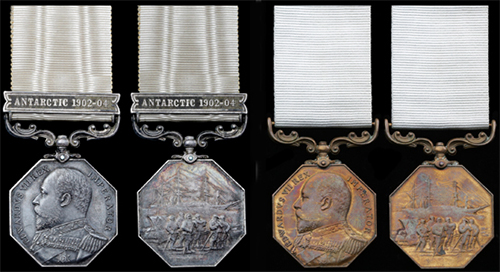
British Polar Medal Edward VII Version for Discovery Mission in Silver and Bronze
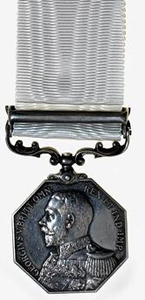
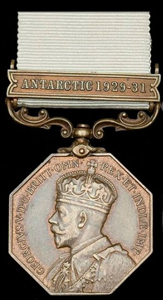
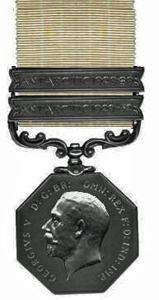
George V Polar Medal Types 1, 2, and 3
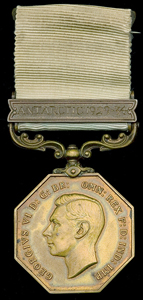
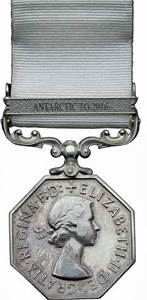
George VI and Elizabeth II Polar Medals
A clasp with the region, ARCTIC or ANTARCTIC, and the date(s) accompany the medal in a finish, silver or bronze, corresponding to that of the planchet. Some bronze medals were issued without clasps. Famous early clasps include: ANTARCTICA 1902-O4 for Scott's Discovery Expedition, ANTARTICA 1907-09 for Shackleton's British Antarctic Expedition, ANTARCTICA 1910-13 for Scott's Terra Nova Expedition and ANTARCTICA 1914-17 for Shackleton's Imperial Antarctic Expedition. The Polar Medal has also been issued with the clasp, ANTARCTIC & ARCTIC TO (Year), since 1986.
Arctic Service includes service north of the Arctic Circle, including all of Greenland and Baffin Island, taking into account the remoteness of the activity from established settlements and air transportation facilities.
Antarctic Service includes service south of latitude 60° S, as well as the islands of South Georgia Islands, the South Sandwich Islands, Herald Island and Bouvet Island, taking into account the seasonal position of the Antarctic Convergence or Antarctic Polar Front where cold, northwest-flowing waters converge with the relatively warmer waters of the sub-Antarctic.
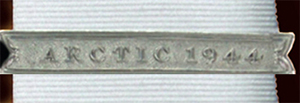
Embossed Silver Artic Clasp Awarded to the RCMP Crew of the St. Roche 1944

Engraved Antarctic & Arctic Clasp
As of 2005, total of 179 different clasps, engraved or embossed, bearing the inscription, ANTARCTICA and the year were issued. Only 73 silver clasps inscribed, ARCTIC and year and 15 clasps inscribed, ARCTIC & ANTARCTIC TO and year were issued. Some early bronze medals were issued without a clasp, but subsequently, 44 distinct bronze clasps have been issued.
In 1974, during the reign of Elizabeth II, the Polar Medal with clasp, ANTARCTIC 1898-1900, was issued retrospectively for the British Southern Cross Expedition. The Southern Cross Expedition was the forerunner of the more celebrated 20th century Antarctic Expeditions to follow. The pioneering expedition, led by Carsten Borchgrevink, was the first expedition to winter-over, the first to discover the Great Ice Barrier later named the Ross Ice Shelf and the first to introduce the use of dogs and sledges. Largely ignored upon his return to England, the 1974 award was intended to "right a wrong."
The renamed and redesigned British Polar Medal, a direct descendant of the 1876 Arctic Medal, would not be awarded until 1904 on the occasion of Robert F. Scott's 1902-1904 Antarctic Discovery Expedition. Thru 2005, 880 silver medals and 245 bronze medals had been awarded for Antarctic research. Another 78 silver medals have been issued for Polar service since then. No bronze medals were ever issued for Arctic service. Bronze medals were presented to personnel on Antarctic relief ships. Since October 16, 1936, all Polar Medals have been awarded in silver. In 1968, the rules governing its presentation of the medal were revised to place greater emphasis on personal achievement. Since 2015, all awards have been announced in January.
The obverse of the 33mm, octagonal-shaped medal features the effigy of the current monarch surrounded their specific curved legend:
King Edward VII is depicted in admiral's uniform with the legend: EDWARDVS VII REX IMPERATOR. 1904 - 1910
King George V is shown in admiral's uniform with the legend: GEORGIVS V BRITT: OMN: REX ET IND: IMP: 1910 -
King George V wearing crown and coronation robes with the legend, GEORGIVS.V.D'G BRITT.OMN. REX. ET INDIAE. IMP. dates unknown
King George V coinage effigy with the legend, GEORGIVS V BRITT: OMN: REX ET IND: IMP: - 1936
King George VI appears bareheaded, facing left with the legend: GEORGIVS VI D:G:BR: OMN: REX F:D: IND: IMP. 1937 - 1952
Queen Elizabeth II is shown uncrowned, facing right with the legend: ELIZABETH II DEI:GRA:REGINA:F:D:+ 1952 - 2022
Charles III coinage effigy is shown uncrowned facing left with the legend: CHARLES III D. G. REX. F.D 2023 -
The reverse, designed by the sculptor Ernest Gillick, RA (1874-1951), depicts Scott's ship Discovery in winter quarters, with a sledging party in the foreground. Some fifty years later, Gillick's wife Mary was to design the obverse for the new Elizabeth II version of the medal. It is suspended by means of a floreated swivel bar. Over the years, the naming has been added in numerous engraved or impressed styles.

British Polar Medal Edward VII Version for Discovery Mission in Silver and Bronze



George V Polar Medal Types 1, 2, and 3


George VI and Elizabeth II Polar Medals
A clasp with the region, ARCTIC or ANTARCTIC, and the date(s) accompany the medal in a finish, silver or bronze, corresponding to that of the planchet. Some bronze medals were issued without clasps. Famous early clasps include: ANTARCTICA 1902-O4 for Scott's Discovery Expedition, ANTARTICA 1907-09 for Shackleton's British Antarctic Expedition, ANTARCTICA 1910-13 for Scott's Terra Nova Expedition and ANTARCTICA 1914-17 for Shackleton's Imperial Antarctic Expedition. The Polar Medal has also been issued with the clasp, ANTARCTIC & ARCTIC TO (Year), since 1986.
Arctic Service includes service north of the Arctic Circle, including all of Greenland and Baffin Island, taking into account the remoteness of the activity from established settlements and air transportation facilities.
Antarctic Service includes service south of latitude 60° S, as well as the islands of South Georgia Islands, the South Sandwich Islands, Herald Island and Bouvet Island, taking into account the seasonal position of the Antarctic Convergence or Antarctic Polar Front where cold, northwest-flowing waters converge with the relatively warmer waters of the sub-Antarctic.

Embossed Silver Artic Clasp Awarded to the RCMP Crew of the St. Roche 1944

Engraved Antarctic & Arctic Clasp
As of 2005, total of 179 different clasps, engraved or embossed, bearing the inscription, ANTARCTICA and the year were issued. Only 73 silver clasps inscribed, ARCTIC and year and 15 clasps inscribed, ARCTIC & ANTARCTIC TO and year were issued. Some early bronze medals were issued without a clasp, but subsequently, 44 distinct bronze clasps have been issued.
In 1974, during the reign of Elizabeth II, the Polar Medal with clasp, ANTARCTIC 1898-1900, was issued retrospectively for the British Southern Cross Expedition. The Southern Cross Expedition was the forerunner of the more celebrated 20th century Antarctic Expeditions to follow. The pioneering expedition, led by Carsten Borchgrevink, was the first expedition to winter-over, the first to discover the Great Ice Barrier later named the Ross Ice Shelf and the first to introduce the use of dogs and sledges. Largely ignored upon his return to England, the 1974 award was intended to "right a wrong."
Website Maintained by Keith Emroll